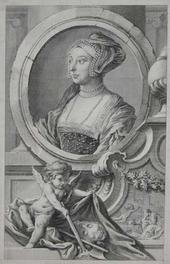 On Good Friday 1533, the 11th April, Henry VIII informed the Royal Council that Anne Boleyn was now his wife and Queen, and ordered them to accord her with royal honours, in the place of Catherine of Aragon who was now the Dowager Princess of Wales.
On Good Friday 1533, the 11th April, Henry VIII informed the Royal Council that Anne Boleyn was now his wife and Queen, and ordered them to accord her with royal honours, in the place of Catherine of Aragon who was now the Dowager Princess of Wales.
This date, 11th April 1533, is recorded in Hans Holbein the Younger’s famous painting, “The Ambassadors”, leading to speculation that it was commissioned by Anne Boleyn, who was Holbein’s patron. The date is marked on the celestial globe, the quadrant and the cylinder sundial. You can read more about this incredible painting, which is full of symbolism and messages in my series of articles:-
- Holbein’s The Ambassadors: A Renaissance Puzzle? – Part One: Context
- Holbein’s The Ambassadors: A Renaissance Puzzle? – Part Two: Symbols
- Holbein’s The Ambassadors: A Renaissance Puzzle? – Part Three: Jupiter and Change
Hi Claire!
May I ask where did you get that picture/engraving from – the one at the top of this article? Looks to be 18th century or there-abouts. But is that a Cupid beneath? Would like to be able to see it enlarged sometime if you can give me a source. Thanks.
Hi Robert,
The engraving is from 1738 and is by Jacobus Houbraken, after Holbein, and it is described “Anne Boleyn (c.1500-36) second wife of King Henry VIII; putto at the bottom of the image reveals Boleyn’s severed head; Jacobus Houbraken (1698-1780) Dutch printmaker”.
See http://eu.art.com/products/p9784735349-sa-i5575623/posters.htm where you can zoom in on it.
Okay so it’s suppose to be Anne in the picture and then her severed head at the bottom aswell? Wow well this is absolutely stunning. I am so going to buy it! It’s gorgeous.
Great engraving, but why is an axe (at least that’s what it looks like to me) depicted alongside Anne’s severed head and not a sword?
I don’t know why there’s an axe and I couldn’t tell if the cherub was holding a sword.
It’s not an axe. It’s a halberd. When Anne, or any traitor, was walked to their trial, guards would accompany them. Anne would have been flanked by at least four guards on all sides, all bearing a halberd facing away from her. Once she (or any traitor) had been tried and convicted, they would have been escorted back their lodgings the same way, but this time with the blades of the halberds facing towards the condemned, symbolizing the fatal and impending sentence of death. That this beautiful work shows the severed head with the halberd is very interesting as it suggests Anne’s innocence, as the blade is faced AWAY from the head, suggesting Anne was wrongfully accused and convicted. I can’t tell what the cherub is holding although I was expecting a sword. My guess is that is is a rod that denotes the sceptre of a ruling monarch and thus denotes
Anne’s regal status.
Just had a zoom on the image and it’s not a sword, looks like some form of taper.
Perhaps this had some significance to the artist, the subject, or the time it was engraved?
Nice article … enjoyed the links to your series on “The Ambassadors.” On the engraving, though, it appeared to me like the cherub was holding a taper, not a sword, but the object near the severed head struck me as being an axe. Maybe, the fact that Anne was beheaded with a sword got lost in the time before the engraving was made?
Poor Anne. She must have thought she “finally arrived” that day.
Big day for Anne.. I imagine how happy and relieved she must have felt that her efforts and perseverance finally brought good results..
Sad day for Catherine, though, it must have been hard to accept, even is she was prepared for something like this, because of Henry’s actions over the years.
Yes, indeed of course, one was triumphanting whilst the other was deprived of her privalliges of Queen and wife and was given the title Dowager and made to live at and in Kimbolton with just a few maids and as it went on the King gradually started to decrease this, the number of the maids that hse had and the place was supposed to be dull and damp which was not right fair or just this could have made her ill and the people living with her, no fit place of stay for someone of Katharine’s position, no fit place of stay for anyone to be in or at.